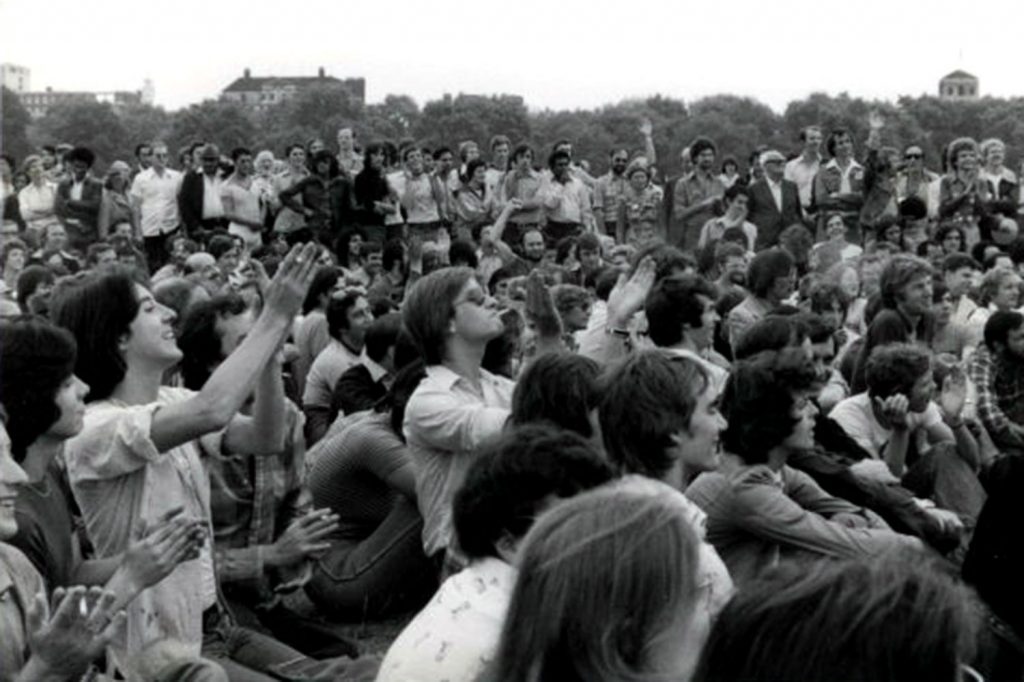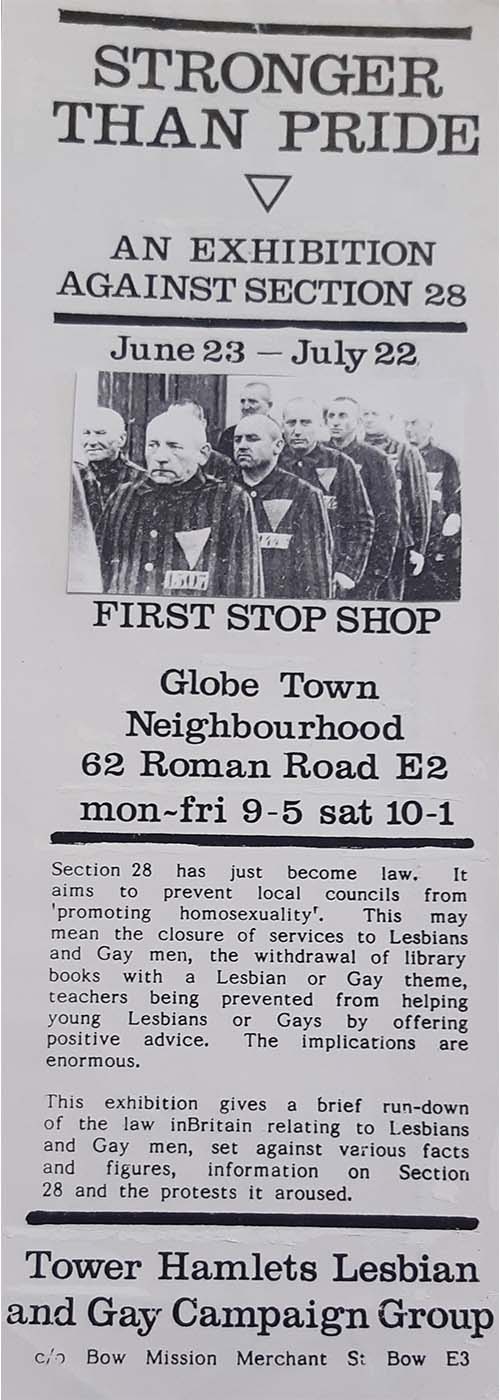Fifty years of Pride in Tower Hamlets: How have we changed as a society?
We celebrate the fifty year anniversary of Pride by looking back at how the LGBT+ movement changed Tower Hamlets’ queer community.
It is hard to believe that just fifty years ago, the idea of celebrating LGBTQ+ identities was borderline illegal in the UK.
Since then, society has changed dramatically, equality is celebrated and LGBTQ+ voices are uplifted.
Lauren Steele, coordinator for Tower Hamlets LGBT Community Forum says: ‘This anniversary is important to bring about conversations and discussions about the queer history that exists, which we may not know exists when we walk down the roads of our neighbourhood.’
Here we look back at the last fifty years, from the first ever Pride March, to how LGBTQ+ attitudes are now blooming in Tower Hamlets.

The first Pride March in the UK 1972
Picture London in July 1972. The streets are filled with shaggy hair dos, flared trousers and flower power. Tower Hamlets was not even ten years old, (it was created in 1965 where it formed from the merging of Stepney, Poplar and Bethnal Green).
For the first time in UK history, LGBTQ+ individuals and allies took to the streets of London for the first ever Pride March. This was a transforming time for many, as for the first time, many queer identifying people could finally celebrate their identity without shame.
Steele says ‘pride is important because it allows us to be visible and celebrate our identity in togetherness. United, we feel like we can take to the streets and be proud to be visible’. The impact of the first pride march was felt all over the UK, including Tower Hamlets, where the search for LGBTQ+ representation ignited.
From here on out, LGBTQ+ communities from around the UK began campaigning for further recognition in society, including our very own Tower Hamlets.

Tower Hamlets Lesbian, Gay Campaign Group (THLGG) 1980s
With the spirit of the rainbow in the air, Tower Hamlets locals set up the Tower Hamlets Lesbian, Gay Campaign Group (THLGG) in the mid 1980s. As part of their work, THLGG produced Out East, a local LGBTQ+ magazine that was delivered door to door. The first edition slipped through local residents’ letter boxes in 1989.
The contents varied from lists of LGBTQ+ friendly shops, to times and dates of meeting places for locals to meet other queer members of society. The magazine even offered medical and faith advice, for HIV+ locals and religious queer people in Tower Hamlets seeking support.
THLGG would meet up regularly as an act of defiance. But they couldn’t just make a quick Facebook group and invite members (Facebook wasn’t invented for another twenty years). Instead, they used flyers to let the community know times and places to meet. Meeting spots included Bromley Public Hall, Globe Town Neighbourhood (which is now Tower Hamlets Social Services building) and Bow Mission.
The magazine played a crucial role in the growth of LGBTQ+ pride in Tower Hamlets, as it united the marginalised queer community. Without the THLGG, the proud voices of the LGBTQ+ community would not be as loud in Tower Hamlets as it is today.

Opposing Clause 28 of the Local Government Bill 1988
In May 1988, Margaret Thatcher’s government announced the anti-gay Clause 28, which banned local authorities from the ‘promotion of homosexuality’. This stopped local councils from funding books and material that showed same sex relationships.
THLGG used its newfound local support to circle Out East copies with meeting times for rallies and marches in defiance. One rally was organised using Issue One of the local magazine, where locals were told to meet at Mile End Tube Station, on June 24 1989. This was one of the first large LGBTQ+ rallies of its time, so next time you walk past the station, let it remind you of this amazing event.
Globe Town Library rejected the bill by supporting THLGG’s campaigns and marches, and producing a list of sixty LGBTQ+ books. On top of this, they continued to accept donations from locals, who owned LGBT+ books they wished to share with their neighbours. Chief Librarian Anne Cunningham declared; ‘the law has been widely misinterpreted in this issue… Globe Town libraries will continue to display books for loan that are of interest to ALL members of the community’. Cunningham’s support provided hope to the community that Tower Hamlets Council had members that stood with the LGBT+ community.
Libraries weren’t the only places to defy the governments anti-gay campaign. In 1988, Morpeth School defied the legislation, by supplying its teachers with Materiography Series No.11, which taught homosexuality as sex education. This included a resource guide to materials about homosexuality, including lesbian and gay literature for use by teachers and librarians in secondary schools and further education colleges.
Victoria Park Pride Festival 1995
In 1995, London Pride made its way to our very own Victoria Park. Taking place on Saturday 24 June, the day began with a rainbow march from Central London to Victoria Park. Around 200,000 supporters joined the celebrations for one of the biggest LGBTQ+ festivals of its time.
The festival’s main stage included Dead or Alive, Erasure, Boy George, Jimmy Somerville and Chaka Khan. The park was filled with market stalls, beer tents, a women’s only disco and various LGBTQ+ entertainment including cabaret, comedy, spoken word and drag. It was thanks to the first ever Pride march twenty three years earlier that made this possible.
The modern uprising of LGBT+ support and voices 90s-00s
Although Margaret Thatcher’s Clause 28 remained in legislation until 2003 – can you believe it – many artists and charities continued to express their stories of LGBTQ+ voices.
In 1991, PositiveEast was formed. Community activists from across East London joined together to establish two organisations with one singular aim – to provide direct care and support to those living with HIV in the East End. They are now one of London’s largest community-based HIV charities.
Gavin Brown, author and local from Tower Hamlets wrote the The Queer Spaces of Tower Hamlets in 1998. In it, he detailed the sizeable gay population in East London. He also noted how his article ‘proposes some ways in which the gay presence in the borough could contribute to the regeneration process’.
After this point, legislation began to change for the better. In 2002 a bill allowed for the equal rights for adoption to same-sex couples. In 2004 the Civil Partnership Act and Gender Recognition Act were introduced, allowing same sex marriage and the Gender Recognition Act and trans people to acquire a new birth certificate. Tower Hamlets locals were involved in marches and rallies that helped encourage the government to make these changes.
Finally, the queer community were being seen in law. Legislation was changing and allowing for the equality of all.

LGBT in Tower Hamlets today
Our final stop on the time machine tour, the present. Tower Hamlets still has an LGBT community hub, in the form of the Tower Hamlets LGBT Community Forum which welcomes all members for meetings and talks. The forum hosts meetings twice every three months, with different themes for each meeting, including Bi and Trans inclusion, safety and ethnic LGBTQ+ support.
Steele explains that the LGBT forum is a ‘safe, non judgemental space. Allies and individuals coming together to encourage changes they want to see and meet other people like them in the area. There aren’t a lot of spaces like that’.
Our area around Roman Road continues to be an important space for hosting and supporting LGBTQ+ events. The LGBT Community Forum meet every last Wednesday of the month. These include Queer East’s film festivals, St Margaret’s House’s LGBT+ guest events, The East End Women’s Museum’s LGBTQ+ workshops and many more.
Times are very different now. People can schedule meetings using computers and mobiles. Online campaigns and petitions can be used to make changes in the community. TV and film has developed into a space where queer voices can be seen and heard in all its glory.
But we should always look back to the people and campaigns that made this all possible. To our ancestors who fought and pledged for equality for LGBTQ+ individuals and shared their stories – thank you.
Enjoyed this piece? Read our article about the Rock Against Racism concert in Victoria Park.








